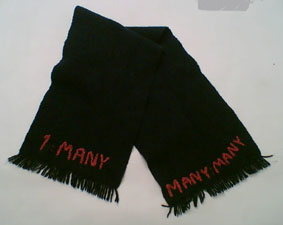|
Language Scarves Open Source Embroidery |
Introduction Exhibitions Html Patchwork Workshops Language Scarves Embroidered Digital Commons Links to interesting things
|


|
|
Language Scarves
Open Source Embroidery
Introduction
Exhibitions
Html Patchwork
Workshops
Language Scarves
Embroidered Digital Commons
Links to interesting things


Shared Language Scarves, 2006 ongoing
The Shared Language Scarves map the terms used to describe creative authorship and engagement across the fields of visual art, digital media, and open methods. The scarves highlight the increasingly politicised tension between art object and social engagement, through the language of open source methodologies. Seemingly opposing words are embroidered at each end of a woollen scarf, usually bought from local charity shops. The scarves are stitched during conferences, seminars, and workshops discussing issues of cultural production, ownership, organisation, and distribution. These events enable the embriodered text to be contested and developed through conversation. Anyone can sew their scarf. The stitched words are discussed below:
1 :Many / Many:Many
1:Many is network distribution ratio for a traditional broadcast model such as television or radio. It was Brecht who first suggested that a radio could be a transmitter as well as a reciever, enabling people to broadcast as well as tune-in, transforming the audience from consumers to producers on a Many:Many network. In art, traditional distribution is based on viewers contemplating an art work created by a single artist (1:Many). Alternatively, in socially engaged art the work produced by many can be re-presented in the gallery as a singular viewing experience. The socially engaged artist may also facilitate a socially engaged project which involves people both as producers and consumers (Many:Many). Early net artists developed open source programmes such as Pirate Radio (Pit Schultz) based on a Many:Many model, enabling people to be both the producers and users of a radio station. This model has now been widely adopted by mainstream media, commonly known as Web2.0. However, the ubiquity of user-generated content and its exploitation should be treated with a critical eye.
Everyone an Artist / Everyone a Programmer
This scarf compares ideas of access to and participation in art and code. Joseph Beuys famously wrote "Everyone is an Artist", whilst Linus Torvalds, the designer of the Open Source Software production process that produced the Linux operating system said "Everyone a Programmer."
Audience / Community of Users
The notion of audience is shifting away from a vague notion of the general public, to more specific communities with particular skills and interests. An art gallery or museum presents art objects to an audience; socially engaged practice develops projects with an audience as participants; open source networks involve their audience as users.
Education / Self-organisation
An art gallery presents objects to enable people to experience them. The purpose of this experience is often described in terms of education and entertainment. In social engagement, the process of participating embodies the knowledge of the experience, and not just the observation of the object. Social engagement facilitates people to value their own cultural experience. Open methods take this pedagogy a step further to encourage self-organisation, where users develop the tools and structures they need to develop and distribute their own culture.
Located Community / Distributed Network
Gallery education and outreach programmes follow funding agendas for priority socio-economic target groups. The social deprivation of these groups is increasingly linked to lack of access to 'culture'. Socially engaged artists work directly with their audiences, often presenting the work back to the (secondary) art gallery audience. Socially engaged practice aims to work with a community's own culture. This is achieved through working with people to identify issues relevant to their locality or specialist area of interest. Eg keeping the local pool open, or exploring common areas of interest such as chess or driving. Networked communication technology defines social relations not in terms of a located 'community' but in terms of it's distributed 'network' mapping the relations between people at different points of time and space. This network enables the development of distributed communities of interest over great distances.
Author / Collective
The relationship between individual and collective authorship is always complex. It often marks a shift from producing or consuming an object to taking part in a wider process of cultural activity. There are many levels of authorship, collaboration, participation and engagement.
Copyright / Copyleft
Free Culture has made a universal call for common ownership such as Copyleft, based on the argument that knowledge should be free and accessible, and reproducable by all. The Creative Commons has challenged the concept of copyright, moving away from a legal structure of ownership to a licence to share. Whilst socially engaged practices have used joint copyright as a way of establishing shared ownership - Creative Commons enables people to license creative material so that it can be shared or reused by others.
Producer / User
Art objects are often produced and consumed by different people. Socially engaged and open source methods involve people in the production of their own culture, which can sometimes be consumed by others in different ways. The open source development model involves users being the producers, or at least contributing to a part, of the production process. In this way, culture is not something you buy, it's something you do!
Consumption / Sustainability
This polarization of 'consumption' and 'sustainability' questions the idea that we can 'buy' our way out of economic and environmental problems. This belief in the market to solve all ills can blur the distinction between something that looks handmade, simply rejecting high production values (ripped jeans, torn paper), and something that is hand-built, modified or adapted according to need. Moving towards a sustainable aesthetic, involves an understanding of the aesthetic of dialogic processes developed through social engagement, enabling people to develop sustainable culture, tools and resources.